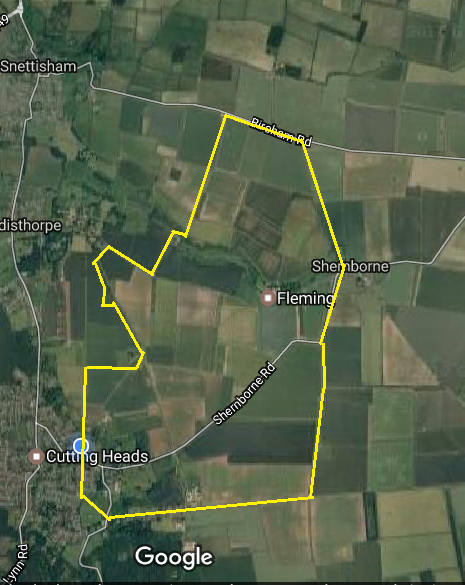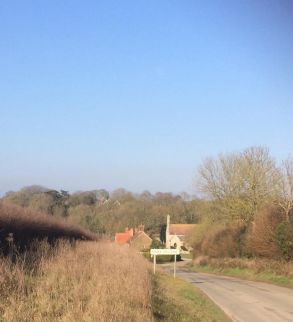Morning and evening, the pink-footed geese fly over the village, their haunting, yelping calls bracketing the day. They fly from the safety of the mudflats and shallow waters of the Wash, that great bay of the North Sea, out to the sugar beet fields, to feed on the shattered remnants of the harvested crop. On that twice-daily commute, they fly over saltmarsh and freshmarsh, woodland and fen, pasture, heath, rivers, hedgerows, village gardens.
I make the same journeys, much on foot, some on foot after driving. I can walk from the village to the sea; I can walk to fen and woodland, arable fields and hedgerows, pasture and fresh water. Open heath, saltmarsh, freshmarsh and larger rivers requires a car. I am here for the birds and the walking, and the great open skies and long views, and the weather that is so much better than Ontario’s from January to March. Three months in winter. These are notes, thoughts, observations, organized more or less by habitat.
Arable, February 14th 2017

Up the hill and along the field paths towards Ingoldisthorpe. Robins and wrens and dunnocks in the hedgerows, the dunnocks singing loudly, perched high. From up here, at the top of the greensand ridge that runs roughly north to south along this part of West Norfolk, I can see over the Wash to Lincolnshire. I’m nearly 5 km from the Wash, but I can see birds – gulls, mostly – moving over the water. There are gulls much closer, too: I pass a sugar-beet field being ploughed: a horde of birds follow the plough, mostly black-headed gulls, but there are one or two common gulls in among them, picking up the exposed invertebrates. Jackdaws strut and search further away from the machine.
The field path skirts Ingoldisthorpe, paralleling a lane and, across the field, the Ingol. The riverbank is treed, and above the trees two buzzards are circling, calling, probably a pair laying claim to their territory. On the ploughed and harrowed field, pied wagtails by the dozen bob and run, searching for food. There’s one grey wagtail amongst this flock, but I can’t find it today.
As I cross the Ingol – I’m on farm track now – blue tits and great tits are feeding on the trees at the edge of the river: the blues higher up, on thinner twigs, the greats lower, on thicker branches, neatly dividing the banquet. Blackbirds scratch among the leaf litter and snowdrops. I’m hot: it’s 10 C, the sun is out, I’m protected from the wind, and I have too many layers on. I remove on layer, stuff the thin shirt in the pocket of my gilet, and keep walking.
Pheasant feeders line the lanes and hedgerows, attracting mostly wood-pigeons, it appears, until partridge explode from beside me. I get the binoculars up in time to see the white faces: red-legged partridge, introduced in the 17th century for sport. A pheasant calls, and another: there are hundreds here, bred and fed for the guns, they’re the most common road-kill, along with muntjac deer, that I see.
On a field on winter wheat four hares catch my attention. Two are sparring, suggesting they are male and female; the other two look on. Hares boxing were long thought to be rival males, but research indicates it’s actually a female interacting with a male, possibly a judgement of the male’s strength and endurance.
I turn off the field paths and up the narrow lane into Shernbourne (which, by its width, delineated by old trees among the hedges, looks as if it was once a drove, the lanes used to move cattle and sheep to market or to grazing). Another covey of partridge break cover, but they’re not red-legged. The grey, or English, partridge, is the native bird of England: Norfolk, and west Norfolk at that, is one of their few strongholds, due mostly to a number of enlightened land-owners and farmers who actively encourage the birds, leaving weeds standing, farming at least part of their land without pesticides (grey partridge need insects as well as grain), and providing cover. In the years we’ve been coming to Norfolk, they’ve gone from extremely rare to a common sight on almost every walk through arable land.
As I descend into Shernbourne, nestled in a fold of land where the Ingol originates, the road-bank is covered in snowdrops. I walk carefully: this is a narrow lane in a deep-sided cutting, with no place to avoid an on-coming vehicle. I’m not worried about cars, particularly, but a big tractor and I could be at a stand-off! Robins sing as I walk through the hamlet, and collared doves coo from roofs.
road-bank is covered in snowdrops. I walk carefully: this is a narrow lane in a deep-sided cutting, with no place to avoid an on-coming vehicle. I’m not worried about cars, particularly, but a big tractor and I could be at a stand-off! Robins sing as I walk through the hamlet, and collared doves coo from roofs.
No tractors. I climb up the other side of the valley on the rough verge: this road is busier, faster, and not a good place to be, especially on the hill. But where the land flattens again, there is a track between two hedges paralleling the road. I walk along this, seeing no birds at all, until it meets an unpaved track that will take me back towards Dersingham.
It’s quiet, very quiet. Time of day is a factor: it’s mid-afternoon, warm and sunny, so there is little need for birds to be actively foraging. But this is also intensive agriculture, probably with high pesticide use. There are belts of planted conifers, for game-bird shelter and for windbreaks on this sandy soil, but I’m not seeing weed strips, or standing maize. A few wood-pigeon, a few jackdaws, the occasional dunnock and wren in the hedge.
I turn off the track and onto the lane that will take me back down, off the high ground, into Dersingham. The lane is narrow, but the verges are wide, and in most places walkable, which is good, because it’s here I meet the big tractor. We exchange waves. At a gap in the hedge I look over the field: there are pheasant and red-legged partridge, and the ubiquitous wood-pigeon.
Just before I begin my descent down Dodd’s Hill I hear them: the pink-footed geese, flying west to the Wash. It’s only three o’clock, early for a return to their night-time roost. What has made them move so soon? Perhaps their feeding field is under the plough today; perhaps they were just satiated with sugar-beet.
I reach the bottom of Dodd’s Hill, cross the road, consider. I’m footsore and thirsty. The pub is right there…time for a cider and crisps, before the last few hundred meters home.
Reblogged this on twosimplelives.
LikeLike
Lovely description.
LikeLike
Thank you!
LikeLike